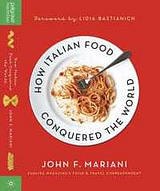
America has a culture and cuisine shaped in most part by its immigrants, and the massive wave of 5 million Italians who arrived between 1880 and 1910 brought with them ideas about food that would completely reshape the American dining landscape. More than 80 percent of these immigrants were from the poor and rural south of Italy, from places like Sicily and Campagna where they knew little of restaurants but had a tradition of simple, hearty fare which they tried to keep up in their adopted country with the paltry ingredients that were available to them.
Since 1860, when the idea of restaurants became popular in France, and for 100 years after, French cuisine defined dining out. It was complicated and time-consuming, a sophisticated world of refinery that shaped people’s ideas about what dining out meant. In this context, the small pizza shops and trattorias serving up Italian dishes of a few simple ingredients were considered mere peasant food, the food of poor immigrants.

Then, the International Olive Oil Council started sponsoring and promoting research about the healthy “Mediterranean diet.” This coincided with the Slow Food movement emerging from Turin, emphasizing the European style artisanal approach to crafting food products. Finally, olive oil was distributed in the U.S. and Italian food became more authentic, something that, as Mariani says, is recognizable to Italians themselves as their own cuisine.
Now, the regional and micro-regional distinctions in Italian cooking are well-known to Americans and olive oil is available in every supermarket. The idea of simple, authentic Italian food, prepared with ingredients of the highest integrity, has become the new standard of dining out in America, one that’s so widespread, it’s hard to imagine that there was a time not so long ago when popular magazines had to explain how to eat a pizza.
Click Here to buy the book from Amazon.








